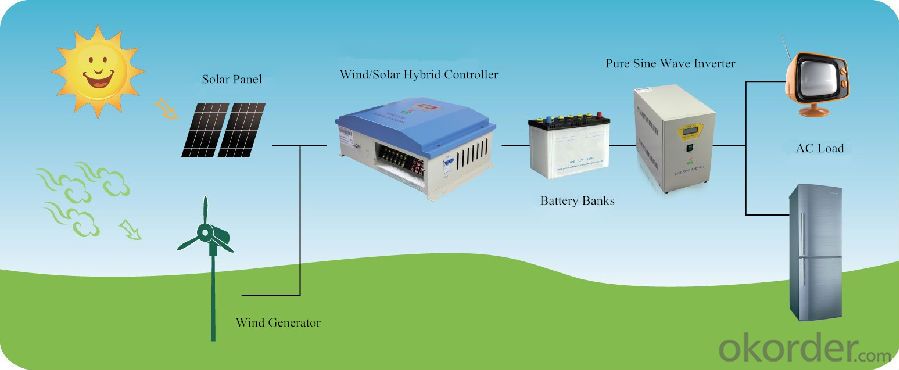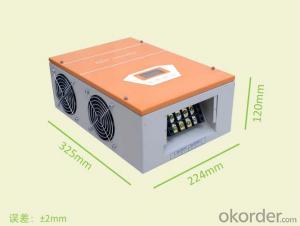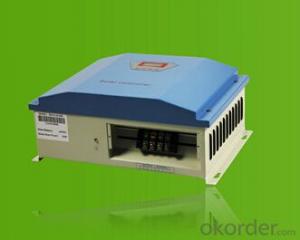1KW-MPPT Charging Function-Solar Charge Controller
- Loading Port:
- Shanghai
- Payment Terms:
- TT or LC
- Min Order Qty:
- 1 unit
- Supply Capability:
- 10000 unit/month
OKorder Service Pledge
OKorder Financial Service
You Might Also Like
I. PRODUCT INTRODUCTION
Solar controller is control device which can control solar panel and transform solar energy into electricity then store to the battery bank. Solar controller is the most important part in off-grid system, whose performance has much effect on life expectancy and operation of the whole system, especially the battery expectancy. Or battery service life will be shortened by over charge or over discharge.
II. PERFORMANCE FEATURES
Superior military-grade components to ensure the product stability.
Perfect protection function, thus the system has higher reliability.
Check and set all operation parameters as requirement from LCD display.
PWM stepless unload mode, which burn the excess power into Dump load, making the battery charging in best status.
III. APPLICATION AREAS
Standalone Photovoltaic power station
Standalone Domestic household photovoltaic power system
Mobil communication base stations, expressway and other non-residential regions.
Coastal islands, remote mountainous, border posts for regions shortage of or without electricity.
Government demonstration projects, landscape lighting project etc.
IV. 1KW TECHNICAL PARAMETERS
Product Model | WS10-24-N00 | WWS10-48-N00 |
Rated battery power | 24V | 48V |
Rated solar input power | 1 kW | 1 kW |
Floating charge voltage | 29V | 58V |
Max Open Circuit Voltage | 50V | 100V |
Dimensions (L x W x H) | ||
Net Weight | 7kg | |
Display mode | LCD | |
Cooling | Fan | |
Protection Level | IP20(Indoor) | |
Quiescent current | ≤20 mA | |
Battery over charge; battery anti-reverse-connection; solar reverse charge protection; solar anti-reverse-connection; lightning protection. | ||
Ambient temperature | -20~+55℃ | |
Ambient humidity | 0~93%, without condensing | |
Working altitude | ≤4000m | |
In order to serve our customers better, our company can adjust parameter configuration according to customer’s requirement. | ||

- Q:What is the maximum voltage that a solar controller can handle?
- The maximum voltage that a solar controller can handle varies depending on the specific model and brand. However, in general, most solar controllers can handle voltages up to 150 volts DC.
- Q:How does a solar controller handle the protection against voltage fluctuations?
- A solar controller handles the protection against voltage fluctuations by constantly monitoring the voltage output from the solar panels. It ensures that the voltage is within a safe range and prevents any surges or drops that could potentially damage the connected batteries or other devices. The controller regulates the voltage by either diverting excess energy or increasing it if necessary, thereby providing a stable and consistent power supply.
- Q:Can a solar controller be used in a solar-powered surveillance system?
- Yes, a solar controller can be used in a solar-powered surveillance system. A solar controller is responsible for regulating the charge from the solar panels to the batteries, ensuring optimal charging and preventing overcharging or damage to the batteries. In a solar-powered surveillance system, a solar controller would play a crucial role in managing the power supply and ensuring continuous operation of the surveillance equipment.
- Q:Can a solar controller be used with solar panel tracking algorithms?
- A solar panel tracking algorithm can be utilized in conjunction with a solar controller. The solar controller's role is to manage and regulate the power flow between the solar panels and the batteries or electrical loads. It ensures that the solar panels are functioning at their utmost efficiency and prevents the batteries from experiencing overcharging or over-discharging. On the other hand, solar panel tracking algorithms are employed to optimize the positioning of the solar panels in order to maximize sunlight absorption throughout the day. These algorithms calculate the sun's position and adjust the tilt and orientation of the solar panels accordingly. By integrating a solar controller with solar panel tracking algorithms, the system becomes more efficient and effective. The solar controller can receive input from the tracking algorithms to modify the power flow based on the real-time position of the sun. Consequently, the solar panels can operate continuously at their optimal angle, resulting in increased energy production. Additionally, the solar controller can provide feedback to the tracking algorithms by monitoring the power output of the solar panels. If any issues arise, such as a decrease in output due to shading or malfunctioning panels, the controller can notify the tracking algorithms to make necessary adjustments. In conclusion, by combining a solar controller with solar panel tracking algorithms, the overall performance and energy production of the solar system can be significantly enhanced.
- Q:How does a solar controller prevent damage to the solar panels from fire hazards?
- A solar controller prevents damage to solar panels from fire hazards in several ways. First, it monitors the temperature of the solar panels and prevents overheating by regulating the amount of power flowing from the panels to the battery or load. If the temperature exceeds a certain threshold, the controller can reduce the charging current or disconnect the panels entirely to prevent further heating. Additionally, a solar controller includes built-in protection mechanisms such as over-voltage and over-current protection. These features ensure that the panels do not produce excessive voltage or current that could lead to a fire hazard. The controller constantly monitors the voltage and current levels and automatically shuts down the charging circuit if any irregularities are detected, preventing any potential damage to the panels. Furthermore, a solar controller also incorporates short-circuit protection. In case of a short circuit in the wiring or load, the controller quickly detects the abnormal current flow and interrupts the circuit to prevent any potential fire hazards. This feature ensures that the panels are not exposed to dangerous levels of current that could lead to overheating and subsequent damage. Overall, a solar controller acts as a crucial safety measure by continuously monitoring the temperature, voltage, and current levels of the solar panels. By regulating and protecting against excessive heat, voltage, or current, it prevents damage to the panels and significantly reduces the risk of fire hazards.
- Q:What is the role of a solar controller in preventing battery self-discharge?
- The role of a solar controller in preventing battery self-discharge is to regulate and control the flow of solar energy to the battery. It ensures that the battery is not overcharged or drained excessively, which helps in minimizing self-discharge and prolonging the battery's lifespan.
- Q:Which is more efficient: PWM solar controller or MPPT solar controller?
- The MPPT (Maximum Power Point Tracking) solar controller is more efficient compared to the PWM (Pulse Width Modulation) solar controller. MPPT controllers are designed to optimize the solar panel's output by constantly tracking and adjusting the operating point to maximize power production. This results in higher efficiency and better utilization of the available solar energy. In contrast, PWM controllers regulate the charging process by switching the solar panel output on and off, which can lead to some energy loss and reduced efficiency.
- Q:How does a solar controller handle high voltage spikes or surges?
- A solar controller handles high voltage spikes or surges by employing built-in protective mechanisms such as surge suppression devices, over-voltage protection circuits, and voltage regulation capabilities. These components detect and divert excess voltage away from the system, preventing damage to the solar controller and other connected devices.
- Q:How does a solar controller prevent damage from reverse current flow in the load?
- A solar controller prevents damage from reverse current flow in the load by incorporating a blocking diode or a solid-state relay in its design. These components ensure that current flows only from the solar panel to the load, preventing any backflow of current. This protective measure prevents the load from being damaged by reverse current and ensures the efficient operation of the solar system.
- Q:What is the maximum power output a solar controller can handle?
- The maximum power output a solar controller can handle depends on its specific design and capacity. It can range from a few watts to several kilowatts, with higher-end controllers capable of handling larger solar power systems.
1. Manufacturer Overview |
|
|---|---|
| Location | |
| Year Established | |
| Annual Output Value | |
| Main Markets | |
| Company Certifications | |
2. Manufacturer Certificates |
|
|---|---|
| a) Certification Name | |
| Range | |
| Reference | |
| Validity Period | |
3. Manufacturer Capability |
|
|---|---|
| a)Trade Capacity | |
| Nearest Port | |
| Export Percentage | |
| No.of Employees in Trade Department | |
| Language Spoken: | |
| b)Factory Information | |
| Factory Size: | |
| No. of Production Lines | |
| Contract Manufacturing | |
| Product Price Range | |
Send your message to us
1KW-MPPT Charging Function-Solar Charge Controller
- Loading Port:
- Shanghai
- Payment Terms:
- TT or LC
- Min Order Qty:
- 1 unit
- Supply Capability:
- 10000 unit/month
OKorder Service Pledge
OKorder Financial Service
Similar products
New products
Hot products
Hot Searches
Related keywords





























